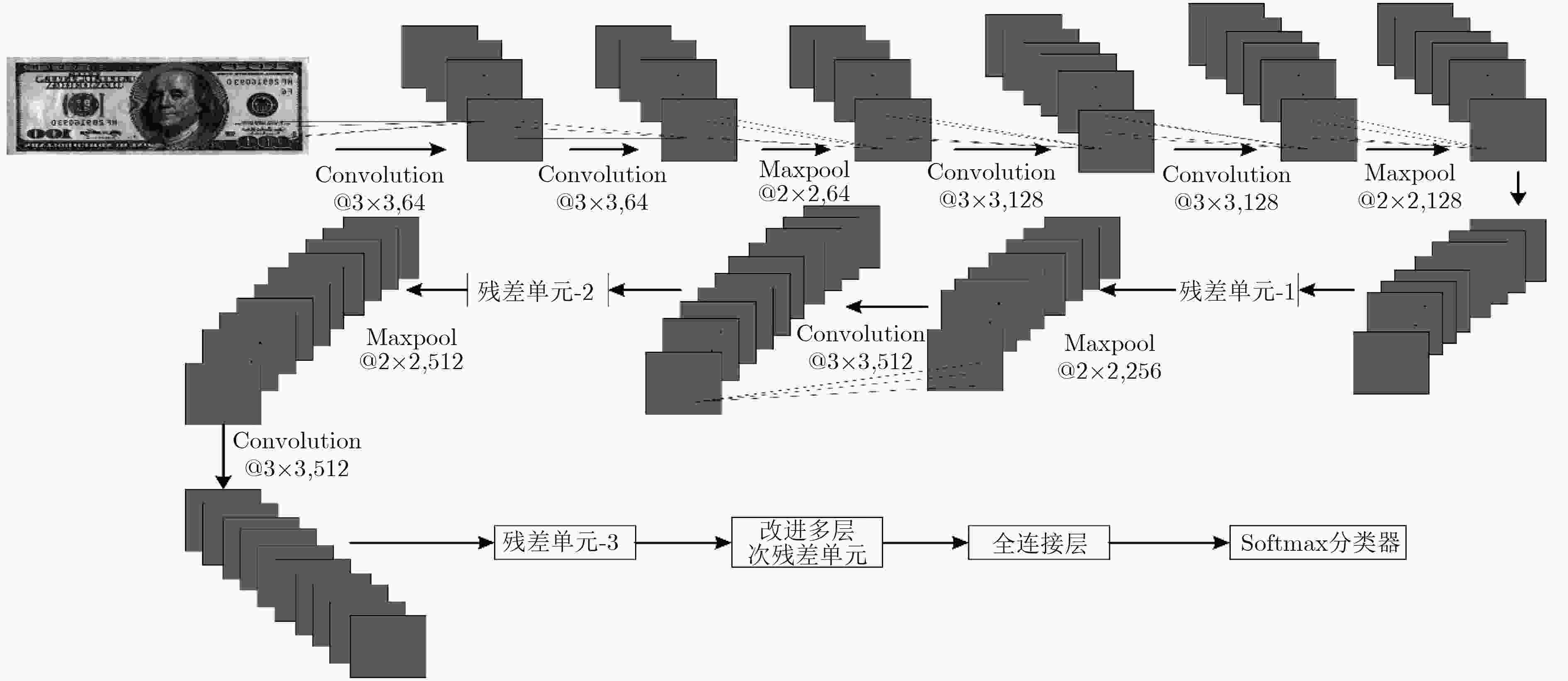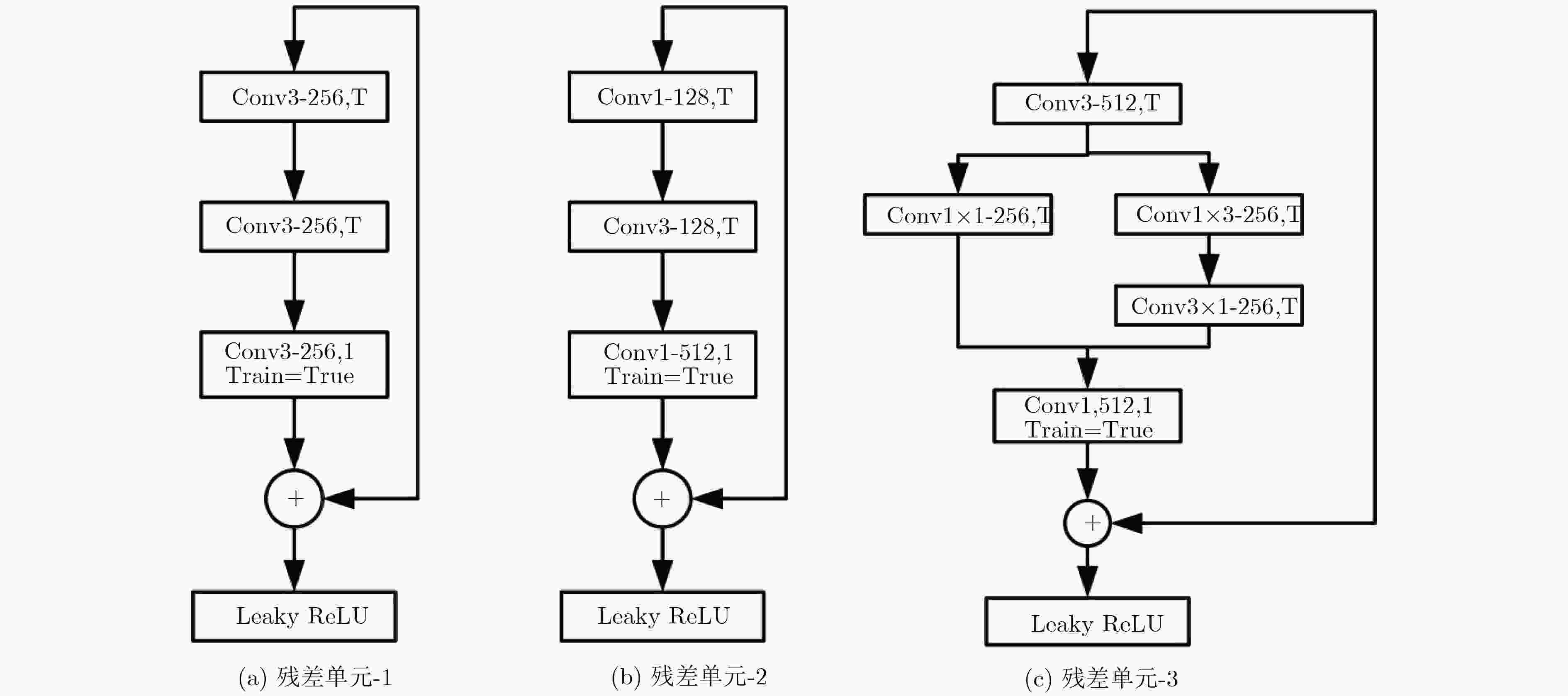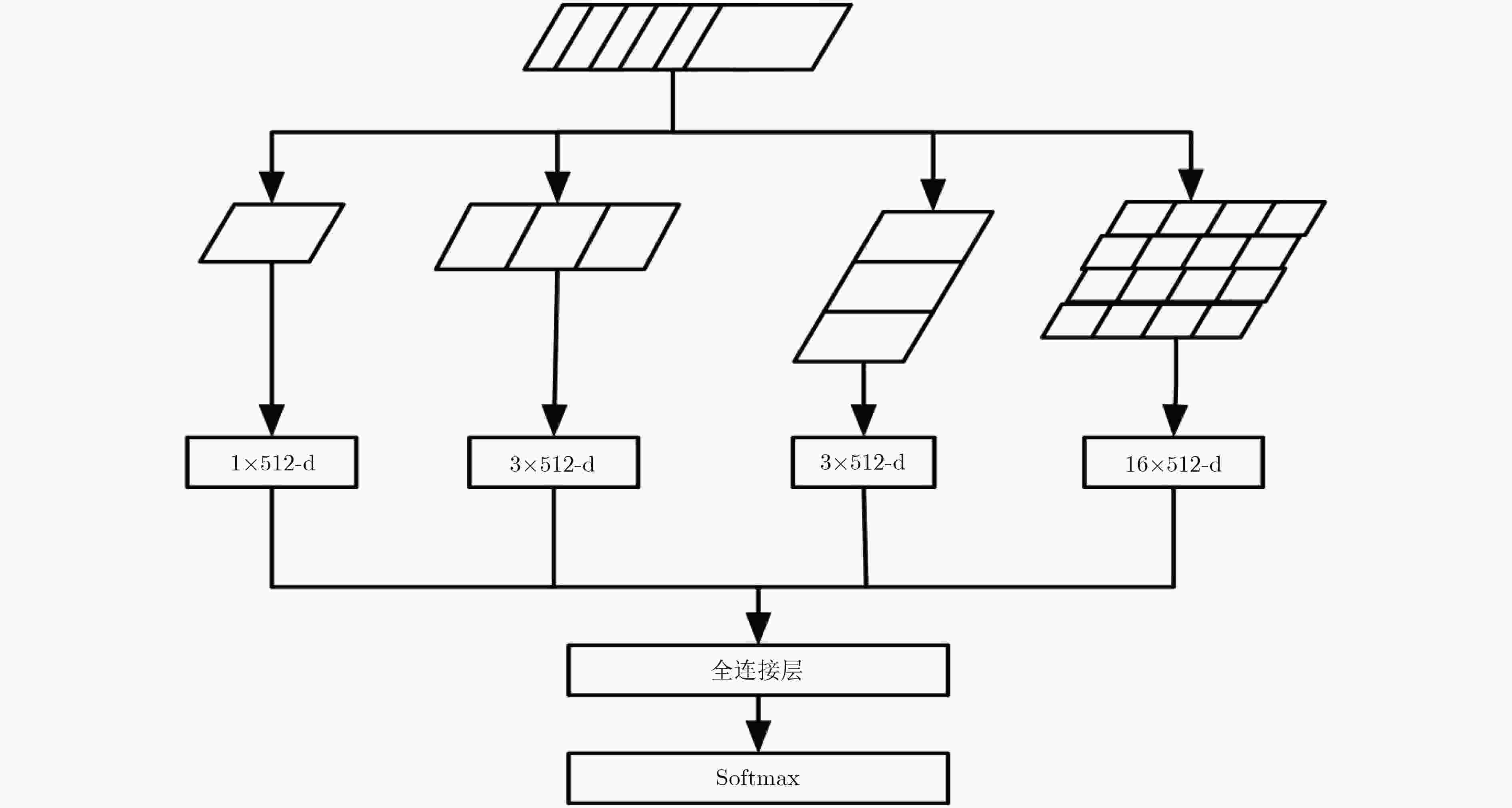Banknote Recognition Research Based on Improved Deep Convolutional Neural Network
-
摘要: 针对如何提高纸币识别率的问题,该文提出一种改进深度卷积神经网络(DCNN)的纸币识别算法。该算法首先通过融合迁移学习、带泄露整流(Leaky ReLU)函数、批量归一化(BN)和多层次残差单元构造深度卷积层,对输入的不同尺寸纸币进行稳定而快速的特征提取与学习;然后采用改进的多层次空间金字塔池化算法对提取的纸币特征实现固定大小的输出表示;最后通过网络全连接层和softmax层实现纸币图像分类。实验结果表明,该算法在分类性能、泛化能力与稳定性上明显优于常用的纸币分类算法;同时该算法也能够满足纸币清分系统的实时性要求。Abstract: In order to improve the recognition rate of banknotes, the improved banknote recognition algorithm based on Deep Convolutional Neural Network(DCNN) is proposed. Firstly, the algorithm constructs a deep convolution layer by integrating transfer learning, Leaky-Rectified Liner Unit (Leaky ReLU) function, Batch Normalization(BN) and multi-level residual unit that perform stable and fast feature extraction and learning on input different size banknotes. Secondly, a fixed-size output representation of the extracted banknote features is obtained by using the improved multi-level spatial pyramid pooling algorithm. Finally, the banknote classification is implemented by the full connection layer and the softmax layer of the network. The experimental results show that the proposed algorithm can effectively improve the recognition rate of banknotes, and has better generalization ability and robustness than the traditional banknote classification method. Meanwhile, the algorithm can meet the real-time requirements of the banknote sorting system.
-
表 1 纸币数据库
纸币种类 纸币面值 纸币分类 纸币样本数 训练样本数 测试样本数 人民币(RMB) 5, 10, 20, 50, 100 20 46000 36000 10000 美元(USD) 1, 2, 10, 20, 50, 100 24 38000 25000 13000 欧元(EUR) 5, 10, 20, 50, 100, 200, 500 28 35000 26000 9000 表 2 数据库DB1平均识别率(%)
表 3 数据库DB2平均识别率(%)
表 4 数据库DB3平均识别率(%)
欧元 网格特征[3] 自由掩模[2] VGGNet19[10] PReLU-net[18] BN-inception[16] ResNet-34B[13] 本文算法 500 81.12 84.23 93.25 92.91 94.56 94.93 96.98 200 81.65 82.32 93.24 94.13 94.68 95.12 98.20 100 85.46 86.94 94.12 94.67 95.23 96.11 97.75 50 79.25 83.24 93.20 93.12 94.35 95, 29 96.79 20 83.24 84.52 94.25 95.28 95.64 96.33 98.76 10 85.33 87.12 94.24 94.76 94.19 97.20 97.88 5 84.20 83.52 94.16 93.26 95.12 95.78 97.89 表 5 污损纸币实际测试识别率(%)
-
KATO N, SUZUKI M, OMACHI S, et al. A handwritten character recognition system using directional element feature and asymmetric mahalanobis distance[J]. IEEE Transactions on Pattern Analysis and Machine Intelligence, 1999, 21(3): 258–262. doi: 10.1109/34.754617 TAKEDA F and OMATU S. High speed paper currency recognition by neural networks[J]. IEEE Transactions on Neural Networks, 1995, 6(1): 73–77. doi: 10.1109/72.363448 刘家锋, 刘松波, 唐降龙. 一种实时纸币识别方法的研究[J]. 计算机研究与发展, 2003, 40(7): 1057–1061.LIU Jiafeng, LIU Songbo, and TANG Xianglong. An algorithm of real-time paper currency recongnition[J]. Journal of Computer Research and Development, 2003, 40(7): 1057–1061. CHOI E, LEE J, and YOON J. Feature extraction for bank note classification using wavelet transform[C]. The IEEE 18th International Conference on Pattern Recognition (ICPR), Hong Kong, China, 2006: 934–937. doi: 10.1109/ICPR.2006.553. GAI Shan, YANG Guowei, and WAN Minghua. Employing quaternion wavelet transform for banknote classification[J]. Neurocomputing, 2013, 118: 171–178. doi: 10.1016/j.neucom.2013.02.029 JIN Ye, SONG Ling, TANG Xianglong, et al. A hierarchical approach for banknote image processing using homogeneity and FFD model[J]. IEEE Signal Processing Letters, 2008, 15: 425–428. doi: 10.1109/LSP.2008.921470 吴震东, 王雅妮, 章坚武. 基于深度学习的污损指纹识别研究[J]. 电子与信息学报, 2017, 39(7): 1585–1591. doi: 10.11999/JEIT161121WU Zhendong, WANG Yani, and ZHANG Jianwu. Fouling and damaged fingerprint recognition based on deep learning[J]. Journal of Electronics &Information Technology, 2017, 39(7): 1585–1591. doi: 10.11999/JEIT161121 樊养余, 李祖贺, 王凤琴, 等. 基于跨领域卷积稀疏自动编码器的抽象图像情绪性分类[J]. 电子与信息学报, 2017, 39(1): 167–175. doi: 10.11999/JEIT160241FAN Yangyu, LI Zuhe, WANG Fengqin, et al. Affective abstract image classification based on convolutional sparse autoencoders across different domains[J]. Journal of Electronics &Information Technology, 2017, 39(1): 167–175. doi: 10.11999/JEIT160241 KRIZHEVSKY A, SUTSKEVER I, and HINTON G E. ImageNet classification with deep convolutional neural networks[C]. The 25th International Conference on Neural Information Processing Systems, Nevada, USA, 2012: 1097–1105. SIMONYAN K and ZISSERMAN A. Very deep convolutional networks for large-scale image recognition[C]. International Conference on Learning Representations (ICLR), Banff, Canada, 2015: 168–175. SZEGEDY C, LIU Wei, JIA Yangqing, et al. Going deeper with convolutions[C]. 2015 IEEE Conference on Computer Vision and Pattern Recognition (CVPR), Boston, USA, 2015: 1–9. doi: 10.1109/CVPR.2015.7298594. SZEGEDY C, VANHOUCKE V, IOFFE S, et al. Rethinking the inception architecture for computer vision[C]. 2016 IEEE Conference on Computer Vision and Pattern Recognition (CVPR), Las Vegas, USA, 2016: 2818–2826. doi: 10.1109/CVPR.2016.308. HE Kaiming, ZHANG Xiangyu, REN Shaoqing, et al. Deep residual learning for image recognition[C]. 2016 IEEE Conference on Computer Vision and Pattern Recognition (CVPR), Las Vegas, USA, 2016: 770–778. doi: 10.1109/CVPR.2016.90. HE Kaiming, ZHANG Xiangyu, REN Shaoqing, et al. Spatial pyramid pooling in deep convolutional networks for visual recognition[J]. IEEE Transactions on Pattern Analysis and Machine Intelligence, 2015, 37(9): 1904–1916. doi: 10.1109/TPAMI.2015.2389824 PENG Peixi, TIAN Yonghong, XIANG Tao, et al. Joint semantic and latent attribute modeling for cross-class transfer learning[J]. IEEE Transactions on Pattern Analysis and Machine Intelligence, 2018, 40(7): 1625–1638. doi: 10.1109/TPAMI.2017.2723882 IOFFE S and SZEGEDY C. Batch normalization: accelerating deep network training by reducing internal covariate shift[C]. Proceedings of the 32nd International Conference on International Conference on Machine Learning, Lille, France, 2015: 448–456. KINGMA D P and BA J. Adam: A method for stochastic optimization[C]. Proceedings of the 3rd International Conference on Learning Representations (ICLR), San Diego, USA, 2015: 1–8. HE Kaiming, ZHANG Xiangyu, REN Shaoqing, et al. Delving deep into rectifiers: Surpassing human-level performance on ImageNet classification[C]. 2015 IEEE International Conference on Computer Vision (ICCV), Santiago, Chile, 2015: 1026–1034. doi: 10.1109/ICCV.2015.123. -






 下载:
下载:








 下载:
下载:
